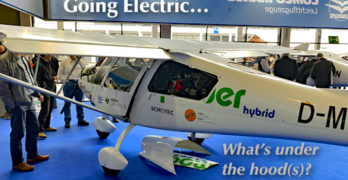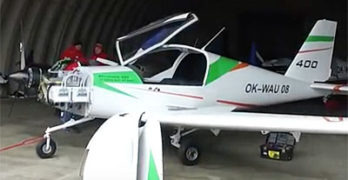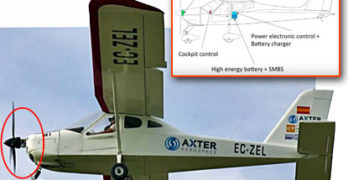A common question from affordable aviation enthusiasts asks about four stroke engines, either for genuine Part 103 ultralights (available but somewhat more challenging) or for very light aircraft. Such inquiries are commonly for aircraft that have previously used a Rotax 582.
The last two-stroke offered by the big Austrian engine manufacturer — builder of the ubiquitous 9-series four-stroke engines — was the Rotax 582. Producing 65 horsepower and earning a good reliability rating over many years, the 582 has been a dependable powerplant for the lightest powered aircraft that are larger and heavier than genuine Part 103 ultralights.
2020 Sensation!
The one and only airshow in 2020 was the Midwest LSA Expo… about to start this week!
Two years ago, in preparation for the show, Chip Erwin lit up the blogosphere with his Merlin Lite entry (image below). Here’s more about that all-metal, weight-making Part 103 aircraft (our most-read article of 2020, which was then our strongest year ever).
Search Results for : Rotax electric
Not finding exactly what you expected? Try our advanced search option.
Select a manufacturer to go straight to all our content about that manufacturer.
Select an aircraft model to go straight to all our content about that model.
Montaer Scores Major Flight School Order; Announces 915 Model for USA plus Electric Project
We leave the grounds of Oshkosh ghosted with images of planes that attracted major interest. From Wisconsin we fly far south to Brazil, home to Montaer and its MC-01, number 154 on our Special Light-Sport Aircraft List.
Montaer will now be represented in the USA by a new group, Aero Affinity, whose ambitions are impressive and pilots may love all the services and choices they are proposing to deliver. Actually, they’re already delivering because the entities making up Aero Affinity are free-standing groups, each functioning in the industry today. Collaborating is a way to offer even more while spreading some of the cost among the group.
This same team made a splash at AirVenture with their matching Aero Showcase logowear. Here’s their website about the inaugural event scheduled for October 21-22, 2022.
For now, however, we’re going to blast part-way around the globe to Brazil where Montaer Aircraft scored big with a large order.
Charging Back into the Lead — Flight Design ga’s F2 and F2e Light-Sport Aircraft (Gasoline or Electric)
Once upon a time in the then-new world of Light-Sport Aircraft Flight Design lead the pack for airplanes delivered and registered. That #1 ranking lasted for a decade.
Then came a pause in the juggernaut that is Flight Design, a German company with a popular design. The company’s expenses outran their revenues and a major restructuring was forced upon them by the German legal system. This was 2015 but at Aero Friedrichshafen 2019, the company was looking strong. Their prominent space in Aero’s huge gymnasium-sized exhibit halls was filled with interesting machines, including the distinctive Horten flying wing.
All these today operate under the parent name, Lift, which also acquired the Rotorvox deluxe gyroplane.
Attracting a lot of attention was their brand-new F-series. Displayed as the first aircraft visitors saw, F2 is an evolved version of the company’s successful CT-series, which remains in active manufacturing.
Aero Friedrichshafen Day 3: ELECTRIC, Hybrid on Tecnam and Comco – Battery on Horten and Bristell
More from Aero as Day 3 closes. Because of the number on display — and because several readers asked — this post will focus on electric propulsion in two distinct forms. Whatever you think about electric as a means of lifting aircraft aloft, escaping its approach appears impossible. Experimentation is happening in all quarters. The following review is far from exhaustive; many other examples could be found at Aero Friedrichshafen 2019.
Most agree that batteries are the weak link in the chain and despite repeated promises of annual increases in energy density of 5-8%, it hasn’t happened over ten years I’ve followed this fairly closely. That does not preclude certain effective uses, for example, local area primary flight training or aerobatic flying. Yet flying cross country on batteries remains somewhere in the future. Nonetheless, projects abound and solutions may be upon us. Here’s what I saw today.
Hybrid Power from Tecnam, Rotax, and Siemens — I had no choice but to drop big names because these three powerhouses are joining forces on a hybrid system.
Sun ‘n Fun Day 4 — Rans Outbound Tricycle, Amphibious Trikes, Electric Powered Paraglider
Sun ‘n Fun streaks on with Blue Angels and Stearmans cracking the air. Exhibits are active. People are shopping for the right airplane. Strong crowds were present at peak times. Opening day may have set a record. Generally vendors and customers seemed to be in good spirits. Recreational aviation looks healthy.
As I spoke with vendors, one comment I heard repeatedly — freely offered but never requested — was “The economy is good. People have money to spend.” This statement came up often enough to give it weight.
Those of you shopping at home can have a little fun with PlaneFinder 2.0. Clicking or tapping a few categories will help you zero in on the best choices for you. Then you can click to articles or videos about them.
Outbound — Rans has enjoyed quite a run with their newest, the S-21 Outbound. It is a handsome taildragger with performance to make STOL designs jealous.
Electric Experimentation Grows; LSA and Ultralights Will Succeed First
As the world appears to shift into overdrive about electric cars, planes, and drones, what is happening in this dynamic, unfolding sector in aviation?
Recent news from Pipistrel spoke to their continued development of their Alpha Electro. This Slovenian company has long pursued this and may be leading in commercialization but — as with electric autos — this remains a minuscule part of total sales. However, it attracts outsized attention from mainstream media, regulators, and others.
Recently, my friend and LAMA Europe associate, Jan Friedrich, alerted me to a new success story.
The Skyleader company is somewhat known in the USA although perhaps by their earlier name Kappa. The more correct name was and is Jihlavan Airplanes but Skyleader is a better marketing name.
Americans have seen examples of the company’s top-of-the-line Skyleader 600 — here’s our video review of the model — but sales have not taken off in this country.
Electric Propulsion Innovations at Aero 2017
Electric aircraft may still have minuscule market share but innovations could change that in the near future. As Aero correspondent, Roy Beisswenger wrote, “This is a rapidly changing technology with both motors and applications showing up all over Aero Friedrichshafen.” This year Aero management concentrated them in one of the big halls where small startups to the heavyweights were located. Thanks to Roy for several reports from Aero, of which this is one. —DJ
Many of the exhibited motors are for very light applications such as light-weight shift control trikes or gliders but motors are becoming more powerful. With an increase in power, new technical problems need to become overcome. For example, the larger the power capability of the motor, the more cooling is required for the motor. Smaller motors are mostly air-cooled, but some of the medium and larger motors require liquid cooling. This doesn’t mean that the motors have radiators, but liquid is built into the motor to help wick heat away from hot spots that are created when electricity is converted to mechanical power.
Forty Years of Rotax Aircraft Engines
Aircraft engine giant, Rotax BRP has reached an anniversary: forty years of making powerplants used around the world by airframe makers of ultralights to Very Light Aircraft. Thus, it was hardly a surprise when Light-Sport Aircraft came along eleven years ago that the Austrian company immediately became the largest supplier of engines … capturing an estimated 80% of the market, even while other ASTM-approved engines are in use from Continental, Jabiru, Lycoming, and HKS. New candidates include Superior’s Gemini Diesel and, of course, the ECi Titan 180-horsepower engine has seen good acceptance. Then we have another batch of engines for kit-built aircraft including Viking (based on Honda), UL-Power, AeroVee (VW), AeroMomentum (Subaru), Corvair, and more.
Despite the many other choices, Rotax has retained a dominant position. I’ve long felt that while it can be challenging to bring a new airframe to market and win some customers, it is even harder to introduce a new engine.
Lightplane Electric Power … Pure or Hybrid?
With our friends at the prestigious Flying magazine putting Airbus’ E-Fan on their July 2015 cover, flanked by a major story inside, it seems everyone is following electric propulsion ever more closely. We’ve been doing it for a while as light aircraft are clearly the first place where electric power is best applied. Airbus may be planning an electric airliner but I don’t expect to see that anytime soon. Meanwhile the giant builder of airliners is indeed pushing forward with a two-and four-seat E-Fan.
However, I see another use of electric motors that strikes me as very compelling, and in the very near term. I wrote about a Spanish project earlier and here is another.
Many years ago when I was a young flight instructor, I dreamed up an idea called JERA, the Johnson Emergency Rocket Assist, born out of a small rocket engine that some gearheads were applying to go-carts on steriods.
Add-On Electric Motor Emergency & Boost Power
A few years back at Aero 2009, Flight Design and Rotax teamed up on a very interesting project. Based on the R-912 engine they added an optional electric motor that could provide additional torque (a characteristic electric motors have in abundance) for takeoff and climb or for emergency power in the event of a failure. The idea more than intrigued me and many others but it quietly disappeared.
Recently a Spanish university announced it had taken this concept to the next step. The team investigating this seemed focused on the emergency factor but opened the door to combined used of electric motor and gasoline engine. In case of a conventional engine failure, while very unlikely, an electric motor can, they said, deliver another 20 kilometers or 12.5 miles of range. That would be a literally saving grace to the pilot and occupants of a troubled aircraft.
Researchers at Universidad Carlos III de Madrid (UC3M) and the Axter Aerospace firm developed an electric propulsion system to install in light aircraft to deliver extra power and range in emergency situations.
- 1
- 2
- 3
- …
- 35
- Next Page »











